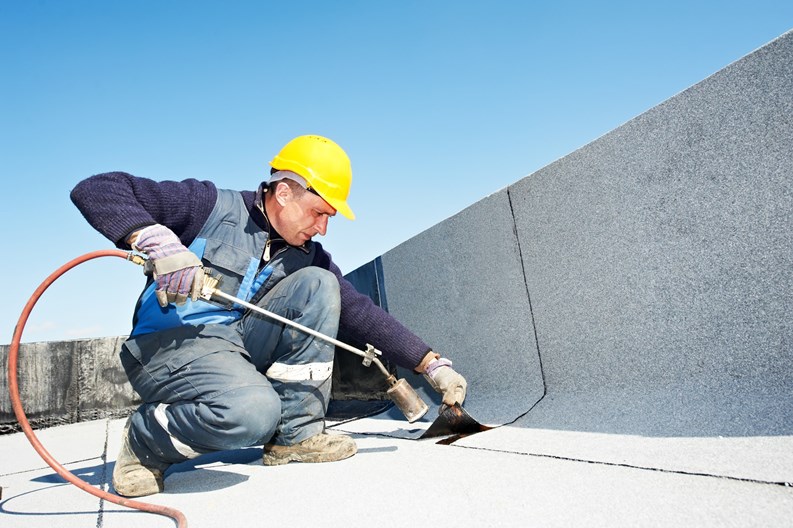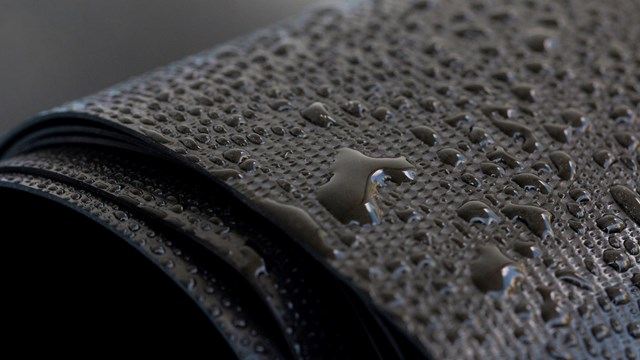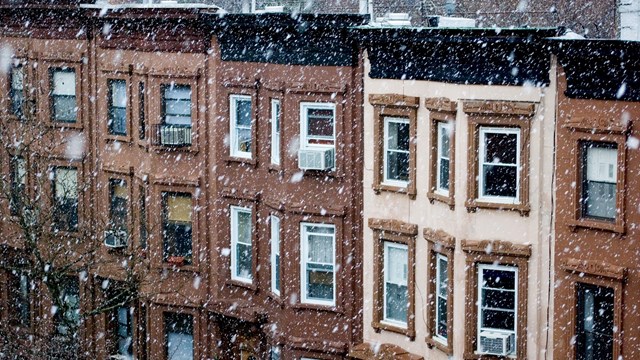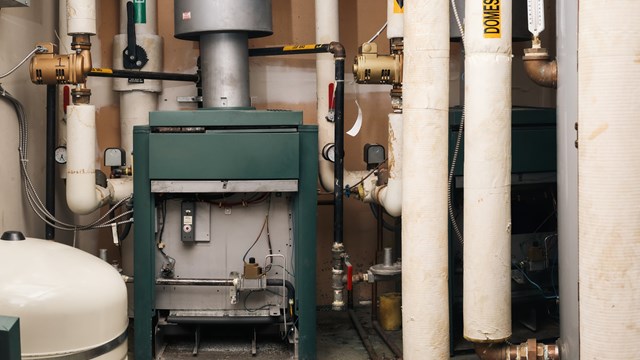Unless you happen to make your home in the Sunbelt, winter is tough, period. The sun goes down at 4 p.m., sidewalk salt ruins your boots, and we all tend to stay home and eat too many carbs.
And while we’re all struggling on the street, hardest hit are the buildings we call home, suffering more wear-and-tear in winter than any other time of year. Snow, ice and frigid temperatures can wreak havoc, causing costly damage and—if that damage isn't remedied ASAP—potential disaster. While chilly days might seem far away now, building and HOA managers, superintendents and engineers and board members can and should be looking for trouble spots now so they can prevent problems later.
From the Top Down
A building’s roof is an easy target for a host of issues, the most common being ice damming. Ice dams are formed when heat—both from inside the building and from the sun overhead—melts snow on the roof. The melted snow then runs into the cold gutters and eaves, where it pools and refreezes. The continual thaw-and-refreeze process creates ice dams, and when an ice dam gets big enough, melted water backs up behind it and seeps underneath the shingles. Eventually, water can drip into the building’s insulation, down into ceilings and exterior walls—potentially ruining sheetrock and paint. If and when the ice dam breaks free, it can take shingles and gutters with it and, if the roof stays wet, mildew can form and rot can begin. Who knew a little snow and ice could be so toxic!
If the ice damming is happening on a new roof, and the problem is because the roof wasn’t designed correctly, it’s the engineer’s fault, says John Tsampas, owner of Skyline Restoration in Long Island City. If the roof was designed correctly, the problem could be the contractor’s fault for not installing the roof properly. But if the roof is an old one on an old building, the ice damming could be a result of the design and nobody’s fault—but, nonetheless, a flaw in need of a remedy.
If that kind of damage occurs, it is easy to play the blame game, but as Spiro Markatos, vice president of Accura Restoration & Waterproofing in Long Island City points out, “It’s not Mother Nature’s fault! So, owners should winterize their roofs before the weather gets bad and make sure the roof edge is in the clear.”
An association can defend against the damage ice dams can cause by having fiberglass insulation installed between the ceiling and roof, which can minimize the heat escaping through the ceiling.
Additionally, the problem can be prevented by ensuring that there’s always a layer of cold air beneath the roof’s surface, says Marciano Stanko, owner of Magnum Opus Architecture, PC in Queens. “That’s typically done through venting in the soffits or eaves of the building,” he says. By allowing the cold air under the roof’s surface, you won’t have the snow melting and creating that river of water beneath the frozen snow. Another way to prevent ice damming is to have a qualified roofer install ice dam prevention material on the roof. A two-foot-wide swath of waterproofing membrane is installed around the perimeter of the roof. With that membrane installed, if any melt-water escapes beneath the shingles, the roof’s waterproof barrier will remain intact. One more option is to install heating cables on the roof, to form a path for melted snow to travel through an ice dam. But heating coils can burn out and are not easily regulated.
Preventing ice damming is just one aspect of proper roof maintenance in anticipation of winter and during the cold months. You must ensure that water always is properly channeled away from the roof. The building engineer or custodian should do this, first and foremost, by ensuring the gutters and downspouts are clean and free of debris at all times. Those connection points between areas of a roof, such as where the roof meets the gutter, or where shingles meet flashing, can turn into problem spots for leaks, if left unchecked for too long. If you’re worried about ice damming or snow accumulation on your roof, have an engineer check the roof and the building’s design. Offering solutions to the problem could cost a small amount of money but do wonders for your peace of mind.
Other Checkpoints
Additionally, Markatos suggests that regular, general housekeeping should be performed to make sure that any damage that has occurred on the roof is addressed before a weak spot gets the chance to become even weaker. Building staff can do a lot, but only so much; a thorough, professional diagnosis of the roof’s health should be done frequently as well. As Stanko says, “Ninety-nine percent of a building’s problems occur at one percent of a building’s surfaces.”
That professional can be a registered engineer or registered architect. In such inspections, the entire building is scrutinized, both visually and physically. Doing a close-up, probing examination of one side of the façade of a building, inspectors will perform a roof-to-foundation “drop down” with a movable platform, not unlike the kind used by window washers. As the platform is lowered, the inspector checks for loose cornices, mortar joints, lintels and sills. Some bricks might be removed temporarily to see if there is any water seepage behind the brick façade. An inspector may also use infrared scanning technology or other methods to test whether the building is leaking an excessive amount of heat through its roof.
During a thorough exterior inspection, the inspector should check to see that the windows have adequate pitch to send water away from the window. A standard pitch is ¼-inch downward to the bottom of the sill.
Caulking around windows should be scrutinized every three years by a qualified inspector, at which time an inspection will be done from the inside to check on integrity of the windows. Depending upon the type of caulking, as well as building conditions and how well the caulking was applied, it could need to be replaced every few years. The only way to know when that job must be done is to have a qualified person inspect the caulking, but residents often can tell when something’s amiss, due to the draftiness inside their unit.
Various parts of your building’s exterior envelope have different life spans, but siding, shingles and roofs last 20 to 30 years if they are properly installed and maintained. When the roof does need to be replaced, though, it could be pricey since such jobs range in cost from $15 to $40 per square foot.
What Lies Beneath
Equally important, though, are the parts of your building that lie below the surface. Throughout the winter, pipes and plumbing should be inspected to ensure they are safe from freezing temperatures. Special attention should be paid to pipes that are in unheated spots in basements, or that are exposed to the elements. “All plumbing on the exterior wall of any dwelling should have proper insulation on it,” says Markatos. “All exterior water sources should be turned off and winterized prior to the first freeze. All hoses and items that can retain water should be drained and store away for winter.” Markatos points out that in a multi family dwelling, this maintenance and winterizing supervision is the responsibility of the building superintendent or manager.
When preparing to winterize a multifamily building in any area that drops below freezing in the colder months, it's essential to pay some heed to the building's boiler. And it's not just a wintertime thing; boilers need to be maintained on a regular basis, not only for proper heating of the building but also because it’s the law in many municipalities.
For example, the New York City Department of Buildings (DOB) requires boilers to have a certificate of operation, and many boilers need to be overhauled annually, with a combustion test done at that time.
Perhaps the most crucial part of maintaining a boiler is employing the right boiler maintenance pro. Such a professional should do regular fireside cleanings of the boiler and at least biannual checkups of the system. As the boiler’s stack temperature increases, it indicates residue buildup and means it’s time for a cleaning.
Stack temperatures and other readings must be done at least a few times a week. Some buildings have the building super do such readings daily. The super and building staff should maintain logbooks for this data, in order to record, compare and monitor daily water level and pressure readings. Summer and mid-winter are good times for checkups/cleaning of the boiler, says Richard Berger, owner of New York Boiler, in Brooklyn.
“In the fall, generally, I’d have a cleaning and inspection” to prepare for winter, Berger says. It’s a day-long job.” During the checkup, gaskets on the boiler should be checked to see that they fit properly. If they don’t, they should be replaced.
No Rush...But Don't Dawdle
You can still enjoy the last days of summer before you have to start thinking seriously about plunging temperatures: most winterizing steps can and should be done after the summer heat has cooled down, but before the first snow. The Superintendents Technical Association’s Director of Education Peter Grech, a resident manager himself, says that by Labor Day, "The super should be looking at the roof and the bricks, because if he does find something, by the time you bring in a professional, it may take five weeks.”
Markatos adds that by the time all of the leaves have fallen off the trees, final checks should have taken place so that when the first snow falls or the first freeze of the season arrives, the building is sealed and snug. After a full walk-through and identification of any necessary repairs, it is all about maintenance leading up to and during the winter—going through the building on a weekly basis to make sure nothing has changed or deteriorated.
In addition to structural care, managers should also make sure they have all the tools and supplies their property will need for the coming cold: sidewalk salt and quality shovels in the winter are snatched up faster than box fans in the summer—so take the time to stock up beforehand. Further, to extend the life of the carpet and flooring in common areas, a long plastic or vinyl runner or mat can be installed in the entryway and common areas to catch all the snow, salt and whatever else that will soil the carpet during the long, dreary winter months.
In the last stretch of summer and the beauty of fall, it’s easy to procrastinate—no one wants to have conversations about snowfall and the “freeze thaw cycle” when they’d rather be sitting in the sun reading, and it’s hard to swallow paying for the prevention of something that is months away. But as Markatos explains, winterization measures are generally not that costly, especially if you are on top of the maintenance. “The majority of winterization is physical labor cleaning and storing unless repairs are required. Then it depends on the extent of the repair. And, ensuring that all insulation is properly installed can reduce heating cost by not allowing heat to escape, ultimately maintaining inside temperature longer and reducing fuel cost.”
There is no way to make winter easier or better—at least not until global warming and climate change wreak full havoc on global weather patterns, anyway. In the meantime, we all have to suffer through flu season and wrapping up like an Eskimo just to go around the block, but the bitterness doesn’t have to be compounded by frozen pipes or a leaky roofs. With forethought and proper care, your building can be the warm, toasty safe haven you so desperately need it to be from November to March. As Markatos says, “Don’t get caught out in the cold!”
Rebecca Fons is a freelance writer and a frequent contributor to The Cooperator.










Leave a Comment